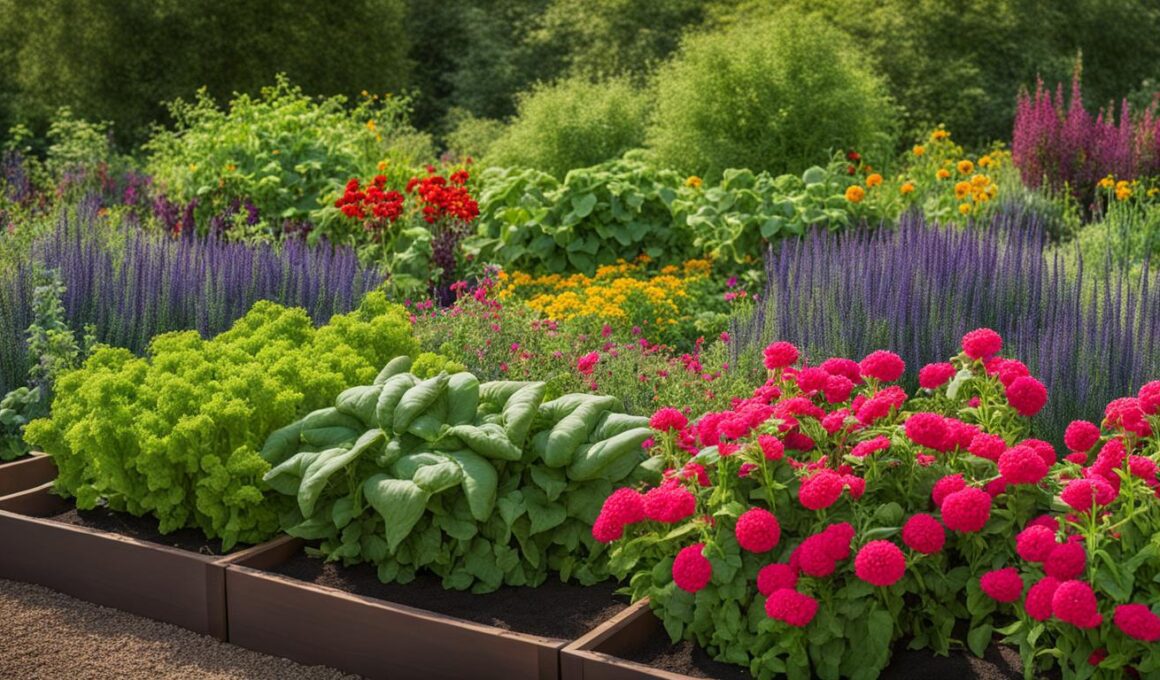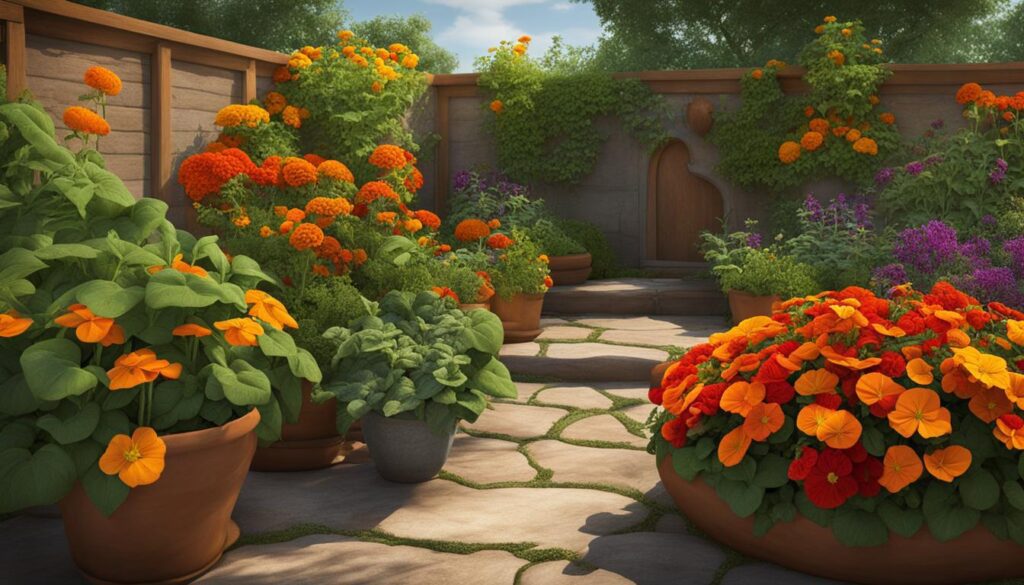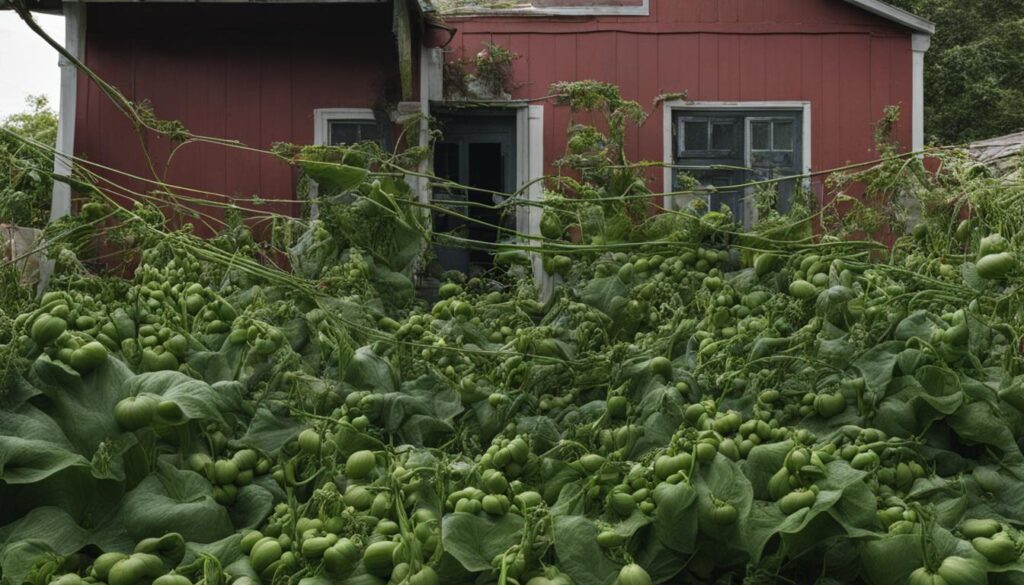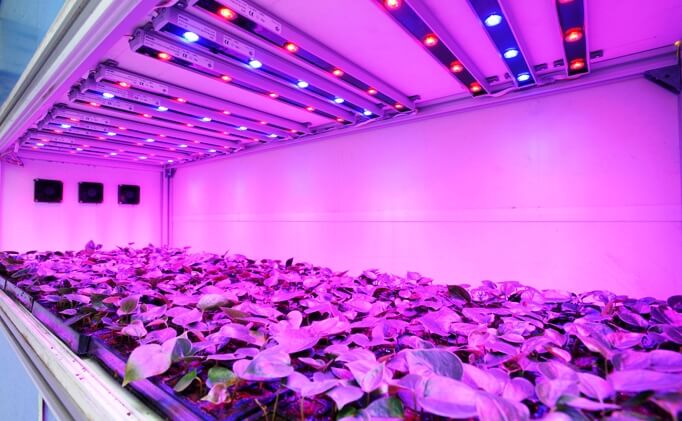Growing bush beans in your garden can be a highly rewarding experience, as they are versatile and full of nutrients. Companion planting bush beans is an effective way to optimize your garden’s potential by maximizing garden yield, bush bean growth, and organic gardening principles. Through the strategic selection of plants, you can also enhance garden pest protection, ensuring healthy and thriving beans.
Key Takeaways
- Companion planting bush beans can improve garden pest protection and maximize garden yield.
- Examples of beneficial companion plants include marigolds, nasturtiums, and various herbs.
- Bush beans contribute to soil nitrogen levels, benefiting other plants in your garden.
- Avoid planting bush beans near incompatible plants, such as members of the allium family.
- Utilize strategic planting techniques to maximize small garden spaces through intercropping and companion planting.
The Benefits of Companion Planting for Bush Beans
Companion planting for bush beans provides a range of advantages that can significantly enhance garden productivity and maximize available space. These benefits include better soil nutrient uptake, organic pest control, and improved overall garden space efficiency. In the following paragraphs, we will explore several bush bean companions and their specific contributions to a thriving garden environment.
- Insect deterrents: Some plants, like catnip, release chemicals that repel a variety of insect pests, including flea beetles, which commonly attack bush beans. Interspersing these natural insect deterrents amongst your bush bean plants can play a key role in organic pest control, resulting in a healthier garden and higher yields.
- Improved nutrient uptake: Certain plant combinations support mutual nutrient use, allowing them to grow harmoniously. Corn, for example, makes an excellent bush bean companion, as the two plants can use soil nutrients without competing against each other. This mutually beneficial relationship provides better soil nutrient uptake and results in stronger, healthier plants.
- Garden space efficiency: Plants like cucumber, eggplant, and radish serve as supportive companions for bush beans. When planted close together, they provide structural support for bush beans while benefiting from the bean’s nitrogen-fixing properties. By choosing these compatible plants, you can increase garden space efficiency and overall productivity.
- Pest and nematode control: Marigolds offer bush beans significant protection against pests and nematodes, thanks to their ability to suppress harmful insects and soil-dwelling pests while attracting beneficial ones. Including marigolds in your garden design keeps your bush beans protected naturally and effectively.
| Plant | Beneficial Effect |
|---|---|
| Catnip | Insect repellent (flea beetles) |
| Corn | Mutual soil nutrient use without competition |
| Cucumber, Eggplant, Radish | Mutual growth support |
| Marigold | Pest and nematode control |
In conclusion, the practice of companion planting offers a wealth of advantages for enhancing the growth and protection of bush beans. By carefully choosing compatible plant partners, gardeners can enjoy increased yields, better pest management, and overall healthier gardens, all while making the most of their available space.
Plants That Help Bush Beans Thrive
A successful bush bean planting strategy revolves around choosing the right companion plants. These plants not only provide support but also improve soil health, deter pests, and enhance bean flavor. Read on to discover marigolds, nasturtiums, and herbs that make great companions for your bush beans.
Marigolds: Pests Repellers and Soil Conditioners
Well-known for their bean pest deterrence abilities, marigolds are a popular choice for companion planting. Their vibrant flowers attract beneficial insects, while their scent repels harmful pests like the Mexican bean beetle. Moreover, marigolds play a significant role in soil conditioning and nematode suppression. African and French marigold varieties release substances into the soil that reduce harmful nematodes, thus protecting the beans growing nearby.
Nasturtiums and Their Dual Role in Bean Health
Nasturtiums serve a dual role in companion planting with bush beans. Their beautiful flowers attract pollinators and repel bean beetle pests, while some gardeners believe that nasturtiums can also improve the flavor and growth of bush beans. As a result, nasturtiums are a wise choice when choosing flowering bean companions, as they create a visually appealing and mutually beneficial garden environment.
Herbs That Complement and Protect Beans
Incorporating herbs into your bean garden not only contributes to organic pest management but also enhances the flavor of your produce. Two exceptional herbs to consider planting alongside bush beans are summer savory and rosemary.
- Summer savory: This herb both repels bean beetles and adds a delightful flavor to your bean dishes. Plant it near the base of your bean plants for optimal growth and protection.
- Rosemary: Known for its aromatic properties, rosemary is another excellent herb for bean beetle pest control. Its strong scent is effective at deterring and masking the beans from pests.
By including summer savory and rosemary in your companion planting strategy, you can ensure flavorful bean cultivation and a thriving garden.
Nutrient Sharing: Plants That Feed Each Other
While interplanting in a home garden is ideal for providing mutual nutrient benefits, nothing exemplifies this principle better than the relationship between nitrogen-fixing beans and other plants. Bush beans, like other legume plants, are capable of nitrogen fixation, a process in which the atmospheric nitrogen gas is converted into a plant-usable form, ammonium. This talent comes from their association with symbiotic bacteria called rhizobia that reside in nodules on bean plant roots. By enriching the garden soil and improving fertility, these nitrogen-fixing beans can benefit neighboring plants that rely heavily on nutrients.
Polyculture gardening benefits become more evident by examining some of the different combinations of plants that benefit from the nitrogen-fixing capabilities of beans.
- Corn: Beans provide a natural fertilizer for corn plants, which require high nitrogen levels. In return, corn serves as a sturdy support for climbing pole beans.
- Partial shade seeking plants: Depending on their type (bush or pole), beans can offer shade and ground cover to nearby plants that might suffer from direct sun exposure.
The importance of understanding and implementing these relationships in a home garden can go a long way in promoting soil health and plant productivity.
| natural_fertilizer | structural_support | shade |
|---|---|---|
| Nitrogen-fixing beans | Corn | Partial shade seeking plants |
In conclusion, focusing on garden designs that incorporate the nitrogen-fixing capabilities of beans and creating plant-driven soil fertility cycles can substantially enhance garden productivity and health. By employing companion planting techniques that include a variety of polyculture gardening benefits, such as mutual nutrient sharing, you can create a sustainable and biodiverse garden that thrives with minimal external intervention.
Avoiding the Unfriendly Neighbors: What Not to Plant With Bush Beans
While companion planting can bring numerous benefits to your garden, it’s crucial to carefully plan your bush beans’ surroundings. There are certain plants to avoid as neighbors for bush beans, as they may cause garden crop interference or negatively affect growth. In this section, we will discuss the main incompatible plants with bush beans and the reasons behind their negative impact.
- Beets (for pole beans)
- Allium family (onions, leeks, garlic, scallions)
- Peppers
- Sunflowers
Beets and Pole Beans: A Clashing Relationship
Although beets may grow well alongside bush beans, they negatively impact the growth of pole beans due to competition for nutrients. Beets and pole beans compete for the same resources, resulting in stunted growth for both plants. In your garden planning, be sure to separate these two plants to maintain optimal growth.
The Allium Family: Chemical Warfare in the Garden
Allium vegetables like onions, leeks, garlic, and scallions can create a hostile environment for bush beans. The allium family and beans don’t mix well because alliums release chemical exudates that kill the beneficial bacteria in the soil that bush beans rely on for nitrogen fixation. To secure your bush beans’ growth and overall health, keep them separate from the allium family in your garden.
Peppers: An Unfavorable Companion
Peppers are another plant to avoid near bush beans. Both bush beans and peppers require similar nutrients, which may lead to competition and affect their growth. To ensure that both plants can thrive, allocate separate spaces for these two crops in your garden.
Sunflowers: A Shade-Casting Shadow
Although sunflowers are attractive and beneficial to pollinators, they can cast heavy shade on bush beans. With less sunlight reaching bush beans, growth is likely to be stunted. Moreover, sunflowers are known to have allelopathic properties, producing chemicals that can inhibit the growth of nearby plants. As a result, it’s best to maintain a reasonable distance between sunflowers and bush beans in your garden.
By avoiding these incompatible plants near your bush beans, you can ensure a bountiful harvest and a thriving garden. Simple adjustments to your garden planning can make a significant difference in maximizing the health and productivity of your bush bean plants. Don’t forget to implement suitable companion planting strategies to further enhance your garden’s potential.
Maximizing Your Garden Space with Bush Beans and Companions
Designing your garden with space-saving techniques and companion planting can significantly improve the productivity of your small garden. With the proper strategy, intercropping, and selection of complimentary plant species, you can make the most of every inch of your garden and maintain healthy bush bean growth.
Strategic Planting Techniques for Small Gardens
Intercropping and companion planting are essential strategies for small garden design, providing numerous benefits such as pest control, nutrient sharing, and optimal plant growth. With the right planter arrangements, your bush beans and their companions can thrive together.
Here are some space-saving techniques for planting bush beans and their companions in small gardens:
- Alternating rows: Plant bush beans alongside their companions in alternating rows or clusters. This arrangement allows for natural pest deterrence and other plant advantages.
- Vertical gardening: Optimize space by growing taller plants or vines along trellises or fences. Consider companion planting bush bean-supporting corn with climbing beans, for instance.
- Utilizing edges and corners: Plant ground-covering or low-growing companion plants like marigolds and chamomile along edges or corners. This technique maximizes available space and helps repel pests.
Complementary companion plants can improve bean health and deter pests. For example, catnip can repel flea beetles, and chamomile can enhance bush bean flavor while attracting beneficial insects.
| Companion Plant | Planting Location | Benefit to Bush Beans |
|---|---|---|
| Marigolds | Along garden edges or in between bean rows | Pest control, nematode suppression |
| Chamomile | Planted within small spaces between bean plants | Attracts beneficial insects, enhances bean flavor |
| Corn | Planted in adjacent rows or clusters to bush beans | Shared nutrients, improved space efficiency |
| Catnip | Integrated within bean rows or along garden edges | Repels flea beetles, improves overall garden health |
By implementing these space-saving garden techniques and considering the benefits of companion planting, you can maximize your garden’s potential and enjoy a bountiful, healthy harvest of bush beans and other crops.
How Can Companion Plants Help Protect and Enhance the Growth of Bush Beans?
Companion plants like pole beans or corn can provide natural support for the bush beans, reducing the need for additional trellis requirements. Additionally, aromatic herbs like sage or thyme can help repel pests that can damage the bean plants, enhancing their growth and protecting them naturally.
Conclusion
In summary, successful companion planting is essential for cultivating a thriving and sustainable bush bean garden. By choosing the right companion plants, you not only enhance bush bean growth but also improve soil health and implement natural pest protection methods. This not only benefits your garden ecosystem but also contributes to healthier, more nutritious produce.
Maximizing garden productivity is achievable by adopting strategic planting techniques and adhering to home gardening tips that revolve around companion planting practices. By carefully selecting bush bean companions and organizing your planting space efficiently, you enable your garden to flourish while reducing the need for chemical fertilizers and pesticides.
Embrace these organic gardening principles and experience the rewards of a well-planned, environmentally-friendly garden. As you continue to nurture your bush bean plants and their companions, your efforts will culminate in a bountiful harvest that you can be proud of, all while fostering sustainability and maximizing productivity in your home garden.











